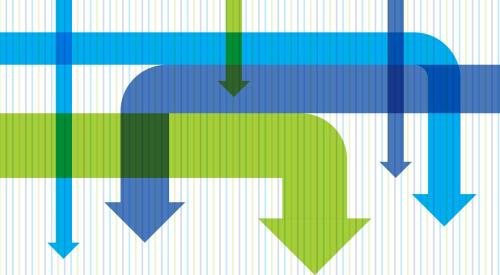If you're looking to reduce operational waste and raise your business' performance, give process mapping a try.
Process mapping is a smart business approach to continuous quality improvement in areas such as product or service quality, customer satisfaction ratings, team productivity and risk management.
My experience in quality processes goes back to days at GE when, in 1990, Jack Welch mandated that every person in every business unit would live and die CTQ — Commitment to Quality. I learned a valuable lesson: quality's foundation is a smart combination of baby steps to do something better and then continuously improve upon it. I also learned that the most critical aspect of any quality initiative starts with you — getting top management to buy in and be an active part of it. You also need everyday champions who play an invaluable role in designing, coaching and enabling the process improvements across your company, business unit or department.
So, how can process mapping help you as a production home builder?
After my presentation at last year's Pacific Coast Builders Conference, Peter Searle, vice president of operations for John Laing Homes in Colorado Springs, Colo., asked us to help him process map several areas of his division's business activities. John Laing's corporate leaders had given a business mandate to every division to:
- Deliver a better, higher quality home in shorter cycle time
- Meet or beat customers' expectations
- Reduce call backs and service costs
- Meet or beat profit targets overall
Searle believed improving interdepartmental communication was central to achieving these overall objectives. With this in mind, he wanted outside help to get his various teams together to scrutinize six critical process areas of their business: land development; new product design; sales and marketing for a new community; individual home sale; construction schedule; and warranty. Following some initial prep work, 30 people from six different departments worked in shifts over three days to identify a rich set of business improvement opportunities.
"It was a great exercise to get everyone on the same page," Searle said. "The various process mapping sessions helped us find both the short-term wins — the low hanging fruit — and some long-term, strategic improvement opportunities to help us grow and meet corporate's big goals for our company."
How to Get Started
STEP 1. Decide what level you want to map. Is it your company; your department; a product or service; or some other aspect of your business that you want to improve?
STEP 2. Select a team of key internal stakeholders (ideally, a maximum of seven per process project) and lock them away for a few hours in a comfortable room with lots of flip charts, markers, sticky notes and refreshments. Don't forget to turn off cell phones to stay focused.
STEP 3. Define what you want to improve (the Big Thing). Then, discuss and define your business goals and objectives for it.
STEP 4. Break the Big Thing down into three to five major subsets. Take each of these subsets and systematically break them down into the most important three to five work steps that make up that process area.
STEP 5. Next, start to dig deeper into each work step by asking probing questions, such as: Who does that particular task? How long does it take? What outcome is produced at the end of the task? Where does the output go?These first steps may take you one to three hours, but you'll find it starts to get your team members really working together and gives them a solid platform to build on.
STEP 6. Now to the meat of the mapping session: What issues do you have in each work step? What causes each issue? Make sure you scribe all the ideas and get them on the flip charts. At this stage, your team members will have created a common understanding of the wasteful issues affecting each business area.
STEP 7. Now, you're ready to brainstorm solutions for improvement, again using flip charts and sticky notes for capturing the ideas. Get your team to open up their minds and propose ideas for improving the situation. And remember that at this stage, no idea is a bad idea, so get them all out on the table.
STEP 8. After this, you're ready to evaluate which opportunities are the best to go after first, next and over time. To start, simply tabulate all ideas on a flip chart. Next, define the stakeholders who would gain from the solution, such as your department, the customer and the trade. Then, have the team suggest the scores for each idea, for every stakeholder on a 1-low, 5-high scale, and tally them up. After this, ask yourselves: Will it be easy, difficult or something in between to implement each solution?
STEP 9. Select the best opportunity projects and define project leaders for each one. After the session, charge the project leaders to develop a game plan to go after for each project, and monitor progress weekly against your improvement goals.
The level of process mapping I've described isn't rocket science. It's simply a way for you and your team to take some baby steps to better understand, analyze, communicate and improve your business processes.
Process mapping can be done in any area of your business, large or small. There is no better time to take on quality-focused initiatives before the market comes back and you find yourself stretched for time again.
In my next article, I'll show you ways to improve your company's performance and consistency through the other half of the process and people puzzle — your team — and explain how you can help them build their knowledge and skills in home-building best practices to take your company to its next level.
Process Mapping Resources
Looking for ideas to help you jump start your learning? Try the following:
- Buy the book Quality Essentials: A Reference Guide from A to Z, by Jack B. ReVelle — an excellent reference tool.
- Read The Goal: A Process of Ongoing Improvement, by Eliyu Goldratt and The Ice Cream Maker: An Inspiring Tale About Making Quality the Key Ingredient in Everything You Do, by Subir Chowdhury.
- Visit SixSigma.com, which provides an excellent overview of quality.
- Check out the National Housing Quality (NHQ) Award for builders.
Michael Dickens is the CEO of BuildIQ, which provides online training and best practices in home building.












